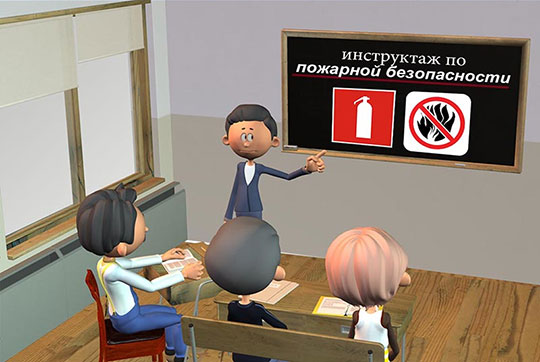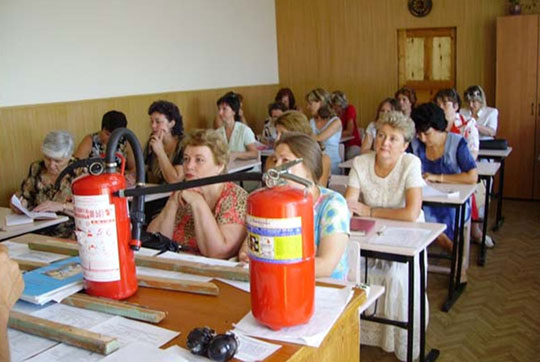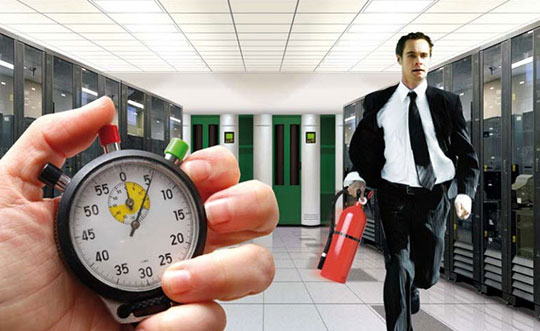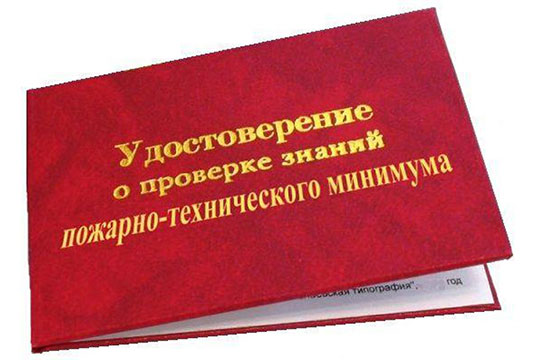Fire safety training program for students
Fire is uncontrolled burning. It would seem that this formulaic, boring definition has long been known to everyone. Therefore, each person must know how to prevent a fire in advance, to localize it safely and quickly and eliminate it if it does occur. The second important question is how to save your life and the lives of those around you in this emergency.
However, hundreds of thousands of fires are recorded in Russia every year. The damage caused by them amounts to tens of billions of rubles, and the amount dead people by the thousands. The reasons that provoked more than half of the cases of fires from their total number are:
- Failure to comply with the rules for the construction and use of electrical equipment and appliances.
- Violation technological processes production or operation of faulty production equipment.
- Careless handling of fire.
- Ignoring rules and regulations fire safety(PB) during fire and welding operations.
- Cases of spontaneous combustion of used raw materials, substances and materials.
Our training center offers heads of organizations to take a fire-technical minimum (FTM) course, as well as to train their specialists responsible for fire safety or carrying out any types of fire-hazardous work. In full-time training, the frequency of formation of groups of students is carried out monthly. When choosing a distance learning format, the schedule is compiled individually. The cost of training is 3500 rubles. The knowledge test ends with the receipt of PTM certificates.
Who needs this type of training?
Legislative acts regulating the need to master the course are the Rules fire regime in the Russian Federation of April 25, 2012 and departmental Order of the Ministry of Emergency Situations No. 645 of December 12, 2007. In accordance with them, the following categories of students should be trained:
- Officials who form the structure of the management team of the organization and its divisions.
- Leading engineering and technical workers ( Chief Engineer, mechanic, technologist, etc.).
- Specialists responsible for compliance with the fire-fighting regime in the organization (conducting fire-fighting instructions).
- Personnel performing hot and fire hazardous work (electric and gas welders, warehouse workers, etc.).
- Persons involved in practical activities professional basis on education and training in educational institutions.
- Heads of children's health camps (suburban health camps, specialized sports and health camps, day camps and others).
- Members of territorial or facility divisions of voluntary fire protection.
Fire safety certificate.
Currently, distance learning is the most common. It is carried out remotely (online). The student is given access to personal account in the form of login and password to the portal. An unlimited amount of time is given independent study lecture material and testing knowledge in the form of testing.
Obtaining a PB (PTM) certificate means successfully passing the test. Updating knowledge is required, as a rule, 1 time in 3 years.
Why is fire safety training necessary?
The overriding goal pursued by the employer is to ensure the safety of the "most precious resource" of the organization - the people who are with him in labor relations. Also, the owners of companies are far from indifferent to the safety of the property assets of their business, which can be destroyed overnight by a fire. And of course, the ability to avoid the imposition of administrative fines (which, by the way, have doubled) is also a good incentive to train your subordinates in PTM courses.
Achieving the above goals allows a training program developed in proportion to all existing regulatory requirements and giving listeners the opportunity to:
- Familiarize yourself with the current regulations legislative framework in the field of food security.
- Learn the rules effective application, maintenance and service primary funds firefighting.
- Master the plan of prescribed actions in the conditions of the spread of uncontrolled combustion, the rules for evacuation from the danger zone, safe methods localization of fires.
- Learn how to provide first aid to victims.
- To study the principles of safe conduct and organization of fire hazardous work (preparation of workplaces, targeted instruction of workers, execution of relevant documents).
How long does it take to send employees for primary training in PB standards?
The employer has a monthly period during which it is necessary to organize training for newly hired employees. It's about about those categories of workers, functional responsibilities which will be to some extent associated with the provision of food security in the organization.
Also, within a thirty-day period, it is necessary to train employees transferred from one position to another (moving a specialist to leadership position, transfer to another unit, specific features production activities in which they differ significantly from the previous place of work, etc.).
When should employees be retrained?
The personnel of enterprises that have fire and explosion hazardous production must undergo annual training in the fire-technical minimum (1 time per year).
This is due to the presence of:
- combustible gases;
- explosive vapor-gas-air mixtures;
- flammable liquids;
- combustible dust or fibres.
Managers and specialists of non-flammable industries must undergo training at least once every 3 years. At the exit, they can get crusts on the PTM.
The training programs were drawn up in full compliance with the regulatory requirements for their content and agreed upon by specialists from the Supervisory Department of the Main Directorate of the Ministry of Emergency Situations of Russia. Below is a list of the main sections included in all training courses, regardless of their duration and target audience listeners:
- Legislative educational program in the field of PB, which is an acquaintance with a selection of existing legislative acts.
- Characteristics of types of fires depending on the conditions of their occurrence and development.
- Assessment of the facility's exposure to uncontrolled fires.
- Rules for the implementation of all required measures aimed at preventing fires:
- establishment of the necessary fire regime in the organization;
- theoretical and practical training of personnel (fire-fighting instruction, plan of fire-tactical exercises, etc.);
- methods of safe organization and conduct of hot and fire hazardous work;
- accommodation and Maintenance primary fire extinguishing means;
- rules for organizing the safe placement and storage of raw materials, materials and finished products;
- inspection and testing of heating, heat supply and ventilation systems.
- Fire protection systems:
- safety requirements focused on ensuring the possibility of prompt and unhindered evacuation of personnel from the danger zone;
- ensuring safe conditions that protect personnel from exposure dangerous factors uncontrolled combustion (automatic fire fighting installations, smoke protection, etc.).
- The gradation sequence of actions of employees of the organization in the event of a fire:
- the procedure and methods for notifying people about the occurrence of uncontrolled combustion;
- assessment of the feasibility of taking measures to localize and eliminate the detected fire and save material assets;
- rules for the use of manual fire extinguishing equipment;
- evacuation management;
- necessary PPE for participants in fire fighting;
- rules for interacting with arriving fire departments:
- meeting of fire departments;
- informing firefighters on the issue of choosing the shortest and most convenient access to the fire;
- providing information about the specifics and characteristics of the enterprise (location of buildings, characteristics of the equipment in operation, information about the properties and quantity of raw materials used, etc.).
How is the course and how long is it?
Volume curricula different for each specific category of listeners. The total number of training hours can vary from 7 to 32. Students choose the format of training on their own.
The standard program lasts 28 hours.
When choosing a full-time form, students will master the fire-technical minimum course directly on the basis of our training center. Classes will be held under the guidance of qualified teachers in rooms equipped with all necessary multimedia equipment.
If your company needs training a large number of specialists, then in this case it is possible for teachers to visit your territory. This option very convenient, because it allows the Customer to independently choose the date of the training and minimize the time the trainees take off from their labor activity. The only thing that will be required from the Customer is the provision of a room that ensures the convenience of conducting classes.
Well, the last, most demanded, format of study is correspondence (distance) training in PB. All that is required is to have a computer connected to the Internet at your workplace. After the payment is made, everyone gets access to a special program containing all the necessary educational materials. You can learn at any convenient time with independent choice the most comfortable intensity of perception of information.
The choice of study format does not affect the content of certificates. They are standardized. The name, position and name of the enterprise are indicated here.
Measures of administrative action for violation of requirements.
- Violation of the requirements entails the imposition of a fine:
- for civilians - from 2,000 to 3,000 rubles;
- on responsible officials- from 6000 to 15000 rubles;
- on the individual entrepreneurs- from 20,000 to 30,000 rubles;
- for enterprises - from 15,000 to 200,000 rubles.
- Violation of the norms, which provoked a fire, as a result of which someone else's property was damaged, or harm was caused to minor or moderate damage to human health, entails the imposition of a fine:
- for civilians - from 4,000 to 5,000 rubles;
- for officials - from 40,000 to 50,000 rubles;
- for enterprises from - 350,000 to 400,000 rubles;
- neglect established requirements PB that caused a fire that caused serious harm to people's health or their death is punishable by the following fines:
- for organizations - from 600,000 to 1,000,000 rubles, or the forced suspension of their activities for up to 3 months.
Greetings, dear reader! I am glad to welcome you to the pages of my security blog. Lately my blog has gained so much popularity that I don't have time to write articles as I try to answer all the questions coming through the feedback form and comments.
Unfortunately, I am not able to answer all the questions in time and on time. To answer some questions, I involve specialists - GPN engineers, designers of low-current systems, APS engineers and technicians. Naturally, this is not only a financial burden, but also a time frame. Therefore, do not be offended if I missed your question or did not find an answer to it. It is impossible to know everything.
I want to dedicate today's article to one very interesting topic– training in fire safety measures for employees of the organization. And it will not even be about briefings, but about the quality of the training that those responsible for fire safety undergo.
You know, sometimes I get such questions in the mail precisely from the people who were appointed responsible for the PB, which takes several days to find an answer. And in essence, this is not a question of a person responsible for fire safety, this should be done by specially trained people. But why is the person who writes to me doing this? It seems to me that this is either from a lack of knowledge, or, like Griboedov, grief from the mind.
And if the latter is the choice of the person himself, then the former must be fought. Let's look at what types of training exist in accordance with the current legislation.
So, according to Art. 25 69-FZ, training is carried out according to special approved programs. And in clause 3 of the Rules for the fire regime in Russian Federation It states that training is carried out in accordance with regulatory documents on fire safety. Such a regulatory document is (Order of the Ministry of Emergency Situations of Russia dated December 12, 2007 No. 645).
Order No. 645 states that if an organization is administered by a federal agency executive power, then the training programs for fire safety measures are approved by the head of this body and coordinated in the manner established by the federal executive body authorized to solve problems in the field of fire safety (EMERCOM of Russia) in accordance with paragraph 52 of the Norms approved by order No. 645.
If the organization is not federal body executive power, then it is necessary to coordinate special programs with the territorial supervisory authorities of the EMERCOM of Russia in accordance with paragraph 53 of the Norms approved by Order No. 645.
Approximate special programs that require approval are given in Appendix No. 3 of Order No. 645. See which programs we need to agree with you.
![]()
But the programs of introductory, primary, repeated, unscheduled and targeted briefings do not need to be coordinated. They are developed and approved within the organization. And briefings are held with all employees.
Conducting fire safety briefings
Fire safety training programs are developed by the administration of the organization. The management of the organization also determines the procedure for conducting briefings.
In order to confirm the conduct of briefings by the inspectors, it is necessary to keep a special log. In clause 10 of the norms approved by the order of the Ministry of Emergency Situations of Russia No. 645, it is indicated mandatory requirement for keeping a log of PB briefings - the signature of the instructing and the instructed.
During the briefing, the employee must be familiar with:
- Rules for the maintenance of buildings and structures, as well as fire safety systems - automatic fire alarm, internal fire water supply, etc.
- Fire safety requirements, taking into account the specifics of production and fire danger in the organization of production activities.
- Measures to ensure safety during the operation of buildings and structures, equipment, etc.
- Rules for the use of open fire and carrying out fire hazardous and hot work.
- The actions of employees in case of fire, the rules for calling fire and rescue crews, the rules for the use of primary fire extinguishing equipment, etc.

And the current legislation requires us to conduct evacuation exercises twice a year. This applies to objects with mass stay people - more than 50 people at the same time.
With briefings and training, in principle, everything is clear, let's move on to the fire-technical minimum.
Fire-technical minimum
Finally, we have come to the most interesting part, the training of anti-tank weapons. Why this is the most interesting now I will explain. The fact is that at one time PTM training was a gold mine for some organizations. No training licenses are needed, therefore, you can save on teachers and the class.
To be honest, I don't know how they teach commercial organizations, I studied at budget courses and this is how the training went: a group gathered and as soon as the teacher entered the class, the most experienced students began to ask to be allowed to go home early.
So the classes were held in a shortened mode. And in principle, it all came down to what needs to be studied regulations, the list of which was on 4-5 pages. Naturally, there can be no talk of any knowledge.
With this approach to training, the fire safety officer is unlikely to know his duties.

There are other options as well. For example, I was approached several times by colleagues with a request to make them a certificate. That is, they wanted to get certificates and not study. This option is even worse - to pay your money not for knowledge, but for some piece of paper. For which a license is also not needed.
Now let's talk about who should be trained in PTM. The categories of those who are required to undergo PTM training are indicated in clause 31 of the Norms approved by order of the Ministry of Emergency Situations No. 645.
However, those who work for explosive objects are trained 1 time per year, and all the rest 1 time in three years.
At the end of the PTM training, knowledge is tested. Those who completed the PTM training should be familiar with the schedule and program for testing knowledge in the field of fire safety.
That's just the knowledge test at the budget courses was not always carried out. Of course, when you urgently need to go to work, since in your absence no one will do anything for you, this training is always out of place. But there are many options, for example, distance learning.
Can you just sign up for the course? distance learning and study at the time that suits you. And distance learning materials presented in in electronic format, you can always save yourself. Isn't this a compromise? What do you think?
![]()
Another thing is that in this case the question of practical exercises, but he is also solving, isn't it?
Therefore, friends, value yourself, your knowledge and the work you are doing. Get quality training. I'm going through quality training right now.
That's all for me, until we meet again on the pages of my blog. By the way, do not forget to subscribe to blog news - I will tell you how my training is going. Share this article with your friends on social networks. Until we meet again, bye bye.
Hello!
Welcome to my security blog. Vladimir Raichev is with you. It’s terribly hot in Moscow right now, it’s simply impossible to work during the day, I wonder why we don’t summer period any siesta?
Imagine: from 12 to 16 o'clock the city is dying out, everyone is escaping from the heat as best they can. It would be good, I guess. On the other hand, during this period, all the same, during this period of time you can’t do any of your work, no one works. Therefore, dreams are dreams, and you have to work in the evening, when the heat subsides a little.
In fact, I deviated a little from the topic of today's conversation, I'm in a hurry to rehabilitate myself: today we will talk with you about how fire safety training is conducted at an enterprise or organization or institution. For simplicity, let's say "at the enterprise".
What do you think this training is all about? Who is the most main enemy in a fire? That's right, panic. Panic prevents a person from concentrating, often it makes him act at the level of self-preservation instinct, and during evacuation this can harm other people.
Incorrect, disorganized and illogical actions during a fire very often lead to irreparable - human casualties. Any confusion of a few seconds can cost someone their life. And imagine if the person responsible for the evacuation, for example, does not know what to do. Really scary? I would be scared.
And if a person clearly understands what is required of him, how he should act, how to organize the actions of others, where to go down the shortest path to the evacuation exit, the person knows that he needs to close the doors behind himself so that there is no oxygen flow, in this case, evacuation is simple doomed to the fact that everything will pass without casualties and like clockwork.
There are a lot of examples, but the main rule is: in case of fire, each person must definitely know what to do. Even in Ancient Russia when it was born fire department, people were severely punished for ignorance of the rules and for their non-compliance. Read how it was.
Regulatory framework for fire safety training
Fire safety in the workplace largely depends on the knowledge and implementation of fire safety rules and regulations by employees. Staff training standards are set by special legislative acts, and it must be carried out in accordance with the requirements of fire legislation, as well as other regulations governing this direction.
PB training is carried out in accordance with Article 25 federal law of the Russian Federation dated December 21, 1994 No. 69-FZ "On Fire Safety" according to specially approved programs. Very well, we have realized the need for training, we are moving on.
But in PPR No. 390 in paragraph 3 it is said that training in fire safety is carried out in accordance with the regulatory documents on fire safety (Order of the Ministry of Emergency Situations of Russia dated December 12, 2007 No. 645 On the approval of fire safety standards “Training fire safety measures for employees of organizations”). Look, we are getting closer and closer to the goal, the truth is already somewhere nearby.
In the same third paragraph of the PPR, it is said that training should be carried out in two forms: in the form of fire-fighting briefing and in the form of a fire-technical minimum.

So, let's figure out who, where and how should study. If you read pp. 36, 37, 39 and 40, then there are clearly defined categories of employees who must receive training in PTM and in what form. I will not dwell on this, this is a topic for a separate article, it will soon appear on the blog. If you don't want to miss it, subscribe to blog updates.
All other categories of workers, it would be logical to assume, will undergo fire safety briefing. As for the briefing, it also has its own characteristics, which should be discussed separately.
Who should be trained and when
Safety training for employees of enterprises that are not related to fire hazardous production should be carried out no later than one month after the specialist starts work, and then at least once every three calendar years. If the production is classified as fire hazardous, then such briefing must be carried out at least once a year.

Many companies provide fire safety training for their staff. The course can be taken by:
- the management of the enterprise, as well as the main specialists working on it;
- employees who are responsible for fire safety;
- employees whose work is characterized by high fire hazard(welding or work with open fire).
After the training course is completed, all participants are issued certificates of the established form. The cost of the course, both for the heads of the enterprise and for persons involved in welding or hot work, is quite democratic, it also depends on the number of trainees, as they say, it is cheaper in bulk.
Where is the training
Training in PB measures is carried out in special centers, which are organized in accordance with all legislative and regulatory acts that regulate this area.
The company providing the training service provides all the necessary knowledge related to fire safety in the workplace. In addition, at the end of the course, you will receive official documents, which will mark the completion of the full course of study in accordance with all legal requirements.

After completing the fire safety training course, you will have employees who will have all the necessary knowledge about conducting fire fighting measures in production, and will be ready to act in any emergency related to fires.
Thanks to this, you will be able to provide proper level safety in their production and protect it both from fires and from claims from the authorities controlling this area.
Well, that's all for today. Train your employees on all requirements normative documents. Don't forget to subscribe to blog updates so you don't miss the articles you are interested in. Share the link to the article on social networks, all the best to you, bye-bye.





